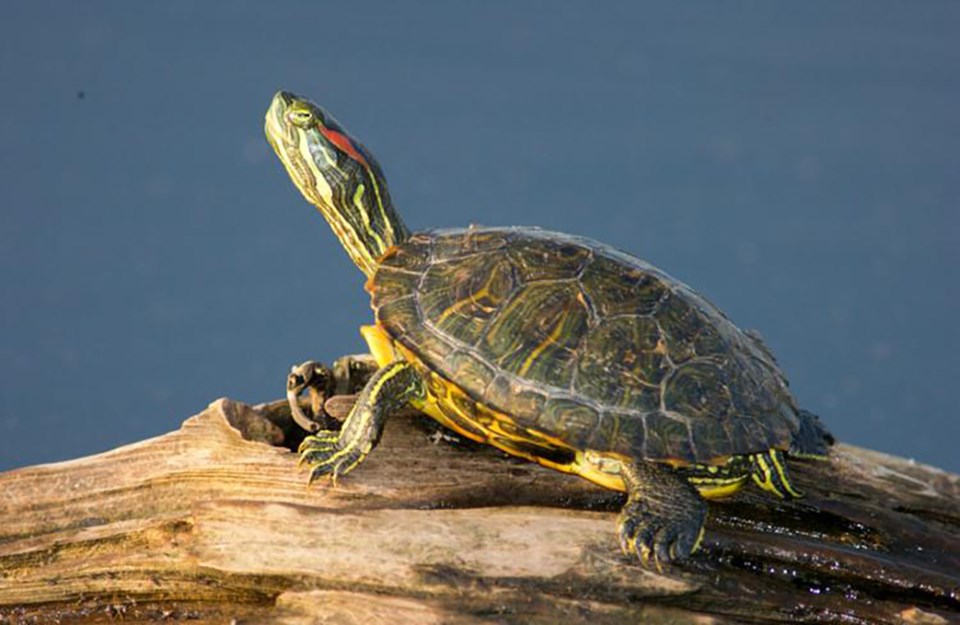Goldfish in stormwater ponds. Burmese pythons in the Florida everglades. And red-eared sliders in Ontario freshwater systems.
Pet-owners have a lot to answer for. When pets – fish, snakes, turtles – get too big for the aquarium, or the owner can no longer take care of it, or the novelty wears off, it might seem like a reasonable thing to some people to set it free.
“They think they’re doing the right thing,” said Kaitlyn Read, Integrated Water Management Specialist with Lake Simcoe Region Conservation Authority.
Except that releasing non-native species into the wild can have unexpected, and often negative consequences.
Trachemys scripta elegans, the red-eared slider terrapin or turtle, matures quickly, has a high reproductive rate and a large body size, and can out-compete native species, like the Midland Painted Turtle and the at-risk Blanding’s and Northern Map turtles.
“They (red-eared sliders) live in the same areas, so they can take up the same basking sites, the same food, the same overwintering sites,” said Read. “They can also carry pathogens that are not native.”
The red-eared slider, named for the red stripe located behind its eyes, is the most popular pet turtle in North America, according to all accounts. A terrapin or semi-aquatic turtle native to the southern U.S. and Mexico, it has also been transported all over the world.
Young red-eared sliders are small, easy to care for, interesting to watch as they bask or feed, and inexpensive to purchase. They don’t take up a lot of space, at least initially. But the terrapins can grow up to 40 cm in length, and they can live 30 years, or decades more.
They also have been known to transmit Salmonella bacteria – a 2012 outbreak of Salmonella in the U.S. was traced to baby red-eared sliders - and their bite as an adult can be painful.
That may be why so many have been released to the wild, including one that was spotted during a ‘Bio Blitz’ at Scanlon Creek Conservation Area, when volunteers were compiling lists of observed species.
Conservation Area staff also located a suspected red-eared slider nest on the bank of Scanlon Creek, and fenced it off in an attempt to ensure the young sliders couldn’t reach the water.
Fortunately, said Read, the eggs never hatched. They turned out to be infertile. But elsewhere in the province, red-eared sliders have become established, and are reproducing.
The red-eared slider is now on the list of the world’s 100 most invasive species, according to the International Union for Conservation of Nature.
Jeff Hathaway, co-founder of Scales Nature Park in Oro-Medonte, a reptile rescue and education facility, did a research paper on feral red-eared sliders in 1994.
“Back then, we knew they were surviving over winter,” Hathaway said. “Now we have absolute evidence of their surviving and reproducing, and babies hatching, in London and Toronto (wetlands).”
Hathaway added: “They are what we call ‘naturalized’ – living and reproducing in the wild in Canada, and in more than 40 countries around the world.”
The released terrapins threaten native species, but it’s not “a panic situation,” Hathaway said. They spread and reproduce slowly. The problem is that seven of Ontario’s eight native turtle species are already considered “at risk,” largely due to loss of habitat, and road mortality – being hit by cars while attempting to cross to breeding grounds.
The red-eared slider, he said “is one more threat for the native species they don’t need.”
Scales Nature Park used to accept unwanted pet turtles – until one turtle brought in a highly contagious disease that basically wiped out the red-eared sliders in the rescue pond. There were fears that the disease would spread to some of the endangered species at the Education Centre but, said Hathaway, “We dodged a bullet there.”
Dealing with unwanted turtles is a challenge.
“There’s a lot more unwanted turtles than people who want them,” he acknowledged. “People buy them as babies and have no idea what they’re getting into. They are often told, ‘It’ll stay small if you keep it in a small container’.”
Limiting the size of the container is more likely to lead to deformity, and disease. And few people realize that turtles may outlive their human owners.
The best way to deal with the issue is education, Hathaway said, addressing the “impulse-buy uneducated consumer” problem. Bottom line: “Never buy a pet turtle. If you want one, there are so many that need a good home.”
If you absolutely have to have a turtle, contact a humane society, OSPCA, Scales Nature Park or Little Res Q. They can help you give an unwanted turtle a good home.
And a reminder to pet owners: If your turtle is too big or no longer wanted, or you can no longer take care of it, contact a humane society, OSPCA or give it to a rescue organization like Little Res Q in Toronto. Just don’t set it ‘free.’
